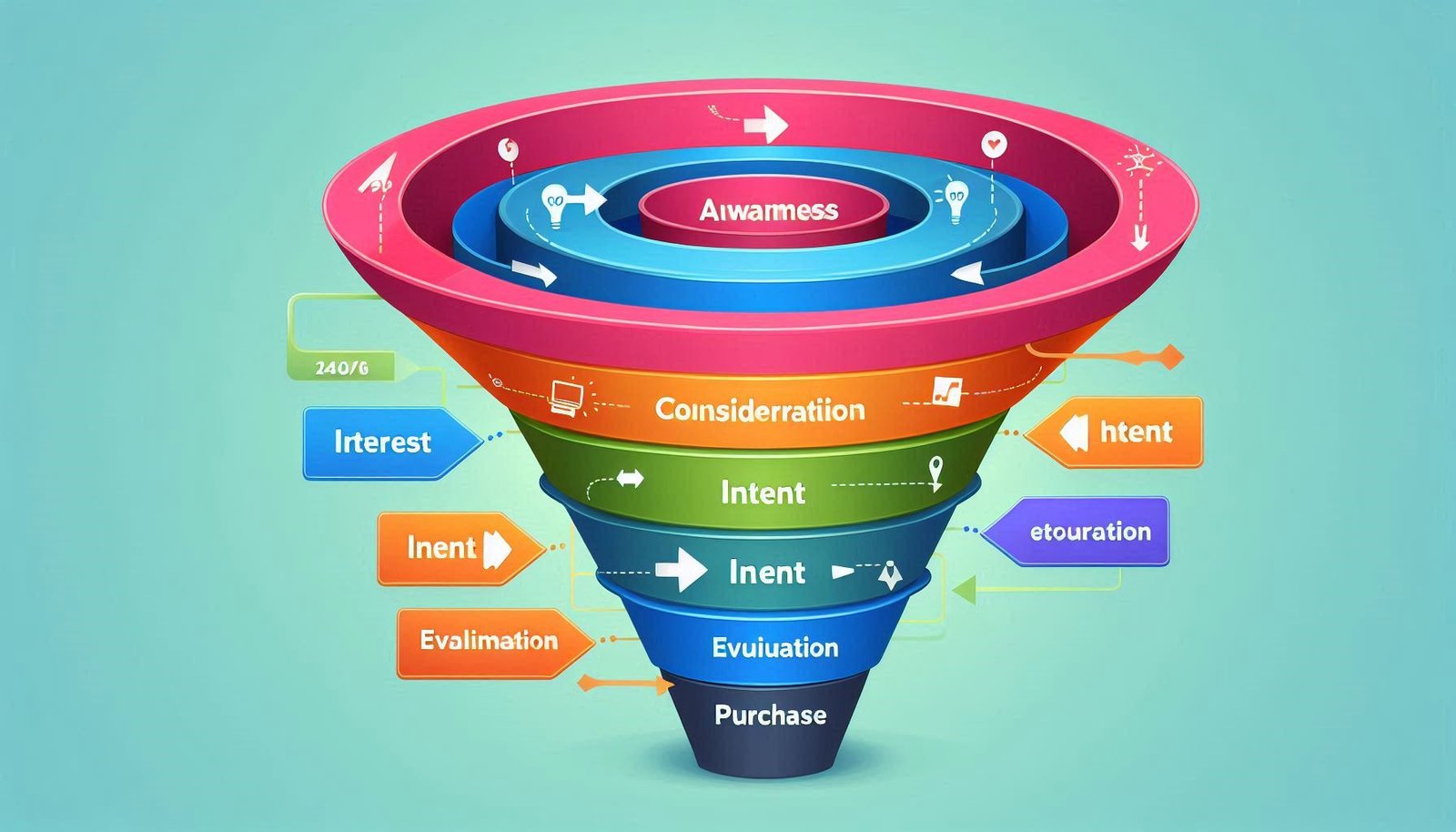In the world of digital marketing and sales, understanding the concept of a sales funnel is crucial for business success. A sales funnel is a step-by-step process that guides potential customers through their journey from initial awareness of your product or service to the final purchase decision. By effectively managing this journey, businesses can optimize their sales strategies and improve conversion rates.
In this blog, we’ll explore the definition of a sales funnel, its importance, the stages involved, how to create one, and tips for optimizing it for better results. Let’s dive in!

What is a Sales Funnel?
A sales funnel is a visual representation of the customer journey, illustrating the various stages potential customers go through before making a purchase. It starts with the awareness stage and narrows down to the final purchase, with various touchpoints along the way.
Key Components of a Sales Funnel
| Component | Description |
|---|---|
| Awareness | The stage where potential customers first learn about your product or service. |
| Interest | Prospects show interest in your offerings and seek more information. |
| Decision | Customers evaluate their options and decide whether to make a purchase. |
| Action | The final step where the customer makes a purchase and completes the transaction. |
Why Do You Need a Sales Funnel?
1. Streamlined Customer Journey
A sales funnel provides a structured path for potential customers, guiding them through each stage of their journey. This streamlined approach ensures that prospects receive the right information and support at the right time, increasing the likelihood of conversion.
2. Better Understanding of Customer Behavior
By analyzing each stage of the sales funnel, businesses can gain valuable insights into customer behavior and preferences. This data helps identify where prospects drop off and what factors influence their decisions, allowing for targeted improvements.
3. Enhanced Lead Nurturing
A well-defined sales funnel allows businesses to nurture leads more effectively. By providing relevant content and personalized communication, you can build trust and establish a relationship with potential customers, ultimately increasing the chances of conversion.
4. Improved Marketing Strategies
Understanding the sales funnel helps businesses tailor their marketing strategies to target each stage effectively. This alignment ensures that marketing efforts resonate with the audience and drive them further down the funnel.
5. Increased Conversion Rates
By optimizing each stage of the sales funnel, businesses can enhance their conversion rates. Identifying bottlenecks and addressing them can lead to a smoother customer journey, resulting in more sales and higher revenue.
The Stages of a Sales Funnel
Understanding the stages of a sales funnel is crucial for effectively managing and optimizing the customer journey. Each stage plays a vital role in guiding potential customers toward making a purchase.
1. Awareness Stage
In the awareness stage, potential customers become aware of your brand, product, or service. This is often the first interaction a prospect has with your business, and it can occur through various channels, including social media, blogs, advertisements, or word-of-mouth.
Strategies for the Awareness Stage
- Content Marketing: Create informative and engaging content that addresses the pain points of your target audience. This could include blog posts, infographics, or videos.
- Social Media Marketing: Utilize social media platforms to reach a broader audience and promote your content.
- SEO: Optimize your website for search engines to improve visibility and attract organic traffic.
2. Interest Stage
Once potential customers are aware of your brand, they enter the interest stage. Here, they seek more information about your offerings and may engage with your content.
Strategies for the Interest Stage
- Lead Magnets: Offer valuable resources (e.g., e-books, webinars, or free trials) in exchange for contact information to nurture leads.
- Email Marketing: Use email campaigns to provide targeted content that addresses the interests of your audience.
- Retargeting Ads: Implement retargeting strategies to re-engage visitors who have shown interest in your products.
3. Decision Stage
In the decision stage, potential customers evaluate their options and consider making a purchase. They may compare your product with competitors and seek testimonials or reviews.
Strategies for the Decision Stage
- Product Demonstrations: Offer demos or free trials to allow prospects to experience your product firsthand.
- Testimonials and Case Studies: Showcase positive feedback and success stories to build trust and credibility.
- Limited-Time Offers: Create urgency by offering limited-time promotions or discounts to encourage decision-making.
4. Action Stage
The action stage is where potential customers make the final decision to purchase your product or service. It is essential to ensure a seamless and straightforward checkout process.
Strategies for the Action Stage
- Clear Call-to-Action: Use strong and clear CTAs that guide customers through the purchasing process.
- Simplified Checkout Process: Minimize friction by offering a user-friendly and secure checkout experience.
- Follow-Up Communication: Send confirmation emails and provide information about what to expect next.
How to Create a Sales Funnel
Creating a sales funnel requires careful planning and execution. Here’s a step-by-step guide to building your sales funnel:
Step 1: Define Your Target Audience
Understanding your target audience is crucial for creating a sales funnel that resonates with them. Develop detailed buyer personas that outline demographics, preferences, pain points, and buying behavior.
Step 2: Map Out Your Customer Journey
Identify the stages of your sales funnel and map out the customer journey for each stage. Consider the questions your audience may have at each stage and how you can provide answers through your content and marketing strategies.
Step 3: Create Valuable Content
Develop content that aligns with each stage of the funnel. This may include blog posts, videos, lead magnets, and product information tailored to address the needs of your audience.
Step 4: Implement Marketing Strategies
Utilize various marketing strategies to attract and nurture leads at each stage of the funnel. This may include social media marketing, email campaigns, and SEO efforts.
Step 5: Monitor and Optimize
Regularly analyze the performance of your sales funnel. Track key metrics such as conversion rates, drop-off points, and customer feedback. Use this data to identify areas for improvement and make necessary adjustments.
Tips for Optimizing Your Sales Funnel
1. Test and Experiment
Regularly test different strategies and approaches within your sales funnel. This includes A/B testing for landing pages, email campaigns, and CTAs to determine what works best for your audience.
2. Personalize Communication
Tailor your communication to meet the specific needs of your audience. Personalization increases engagement and improves the chances of conversion.
3. Utilize Marketing Automation
Implement marketing automation tools to streamline your sales funnel processes. Automation can help with lead nurturing, email campaigns, and tracking customer interactions.
4. Monitor Key Metrics
Keep a close eye on important metrics, such as conversion rates, customer acquisition costs, and return on investment (ROI). These metrics provide valuable insights into the effectiveness of your sales funnel.
5. Gather Customer Feedback
Solicit feedback from customers to understand their experiences and identify areas for improvement. This can be done through surveys, interviews, or reviews.
Feature Snippet: Quick Sales Funnel Tips
- Define Your Audience: Know who you are targeting for more effective messaging.
- Create Valuable Content: Provide information that addresses your audience’s needs at every stage.
- Monitor Performance: Regularly track metrics to identify areas for improvement.
- Personalize Communication: Tailor your messages to increase engagement.
Challenges in Implementing a Sales Funnel
1. Complexity of Customer Behavior
Understanding customer behavior can be challenging due to its complexity. Prospects may not follow a linear path through the funnel.
Solution
Utilize analytics tools to track customer interactions and behavior patterns. This data helps in refining your approach.
2. High Competition
In a competitive market, standing out can be difficult. Many businesses are vying for the same audience.
Solution
Focus on your unique selling proposition (USP) and communicate it effectively through your marketing strategies.
3. Maintaining Engagement
Keeping potential customers engaged throughout the funnel can be challenging, especially with distractions.
Solution
Implement lead nurturing strategies, such as personalized emails and targeted content, to maintain engagement.
Conclusion
A sales funnel is an essential framework for businesses looking to optimize their sales processes and improve conversion rates. By understanding the stages of the funnel and implementing effective strategies, you can guide potential customers through their journey from awareness to action. Regularly monitoring and optimizing your sales funnel ensures that you remain responsive to customer needs and market trends.
As you embark on building and refining your sales funnel, remember that it is a dynamic process that requires ongoing attention and adaptation. By prioritizing customer experience and providing valuable content at every stage, you can achieve greater success in your sales efforts.
Call to Action
Ready to build your sales funnel and boost your conversions? Explore Guruji Sunil Chaudhary’s courses to learn powerful strategies for effective sales funnel management!








